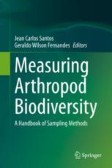Search
Search Results
-
The Biodiversity of Blackflies (Diptera: Simuliidae) in Brazil: New Distribution Records and Updated Checklist
Currently, according to the most recent Simuliidae World Inventory, there are 97 valid species of blackflies recorded in Brazil, some of which act as...

-
Sampling Techniques for Bloodsucking Dipterans (Diptera: Culicidae, Simuliidae, Ceratopogonidae, Tabanidae)
AbstractTechniques for sampling and preserving bloodsucking dipterans: mosquitoes, blackflies, biting midges, and horseflies (Diptera: Culicidae,...

-
Structure and diversity of blackfly assemblages in the Luvuvhu River system, South Africa in response to changing environmental gradients
Blackflies are amongst the most abundant and diverse group of aquatic insects globally, being rarely absent from rivers, their distributions are...

-
Reduction in the Numbers of Blood-Sucking Blackflies in Volgograd during the 2018 World Cup as Special Task of Complex Water Resource Management of the Cascade Reservoir System
AbstractA mass emergence of blood-sucking blackflies in the Volgograd and Astrakhan oblasts is annually observed in May to July. The blackflies are...

-
Landscape–Zonal Distribution of Blackflies (Diptera: Simuliidae) in the Ob-Irtysh River Basin (Overview)
The blackfly distribution patterns along the meridional profile for the Ob-Irtysh River basin area have been analyzed with the use of long-term...
-
Biopesticides: Uses and importance in insect pest control: A review
Biopesticides are made up of plant materials that kill insects and a variety of microorganisms that kill insects, such as entomopathogenic fungi,...
-
Contribution to the Blackfly Fauna (Diptera: Simuliidae) of North Ossetia–Alania
AbstractThe records of 15 species of blackflies (Diptera: Simuliidae) in the Republic of North Ossetia–Alania are given. Prosimulium anatoliense and Simulium...
-
Feeding Features of the Nine-Spined Stickleback Pungitius pungitius (Gasterosteidae) In Water Bodies of the North-West of Russia
AbstractThe diet of the nine-spined stickleback Pungitius pungitius has been studied in two water bodies in the north-west of Russia: in the...

-
Parasitic Helminths and Arthropods Infections in Camel: Diagnosis and Control
Camels are important domestic adaptable mammal native to dry and semi-arid climates. It not only provides transportation to individuals living in...

-
Sampling Methods for Blood-Feeding Insects Diversity
Insect vectors are responsible for transmitting several pathogens during their blood feeding on vertebrate hosts. They can also reduce the...
-
Detection of Wuchereria bancrofti DNA in wild caught vector and non-vector mosquitoes: implications for elimination of lymphatic filariasis
BackgroundTransmissionAssessment Survey (TAS) is the WHO recommended method used for decision-making to stop or continue the MDA in lymphatic...

-
Macrozoobenthos Communities in Small Tundra Lakes of the European Northeast of Russia
AbstractThe benthic communities in some large tundra lake ecosystems of European Russia are well-studied, but information on zoobenthos in small...

-
The Bacterial-Fungal Consortia: Farmer’s Needs, Legal and Scientific Opportunities, and Constraints
In the ecosystemecosystem, the plant microbiomemicrobiome is often in association with other microorganisms like bacteriabacteria, actinobacteria,...
-
True Flies: Diptera
The flies and midges within the order Diptera (true flies) bear membranous forewings, whilst their hindwings are vestigial, modified into balancing...
-
An experimental test of colonization traits at a patch-scale in Andean Neotropical streams
Characterizing dispersal traits can further our ecological understanding of Neotropical stream macroinvertebrate communities, allowing us to test...

-
Depth-specific benthic specialization of Arctic char in an oligotrophic subarctic lake
Fishes consume prey from across both benthic and pelagic habitats, thereby stabilizing the food webs of freshwater lakes. How fish exploit vertical...

-
Review of State-of-the-Art Research on River Hydrological Hazards, Restoration, and Management
River’s health and self-sufficiency are depending on a variety of factors. One of the most important components for a steady supply of clean water is...
-
Research on medical and veterinary entomology in the insular Caribbean: a bibliometric analysis
Research on medical and veterinary entomology (MVE) is especially needed in the Caribbean islands, which are threatened by the burden of several...

-
Description and molecular characterization of novel Leucocytozoon parasite (Apicomplexa: Haemosporida: Leucocytozoidae), Leucocytozoon polynuclearis n. sp. found in North American woodpeckers
We describe Leucocytozoon polynuclearis n. sp. (Haemosporida: Leucocytozoidae) from two North American woodpeckers, the northern flicker ( Colaptes...

-
The Origin of the Northern Palaearctic Fauna of Bloodsucking Insects, by the Example of Fleas (Siphonaptera), Mosquitoes (Diptera: Culicidae), and Blackflies (Diptera: Simuliidae)
The territory of Fennoscandia and northwestern European Russia was released from the glacier cover in the Upper Pleistocene and has been recolonized...
